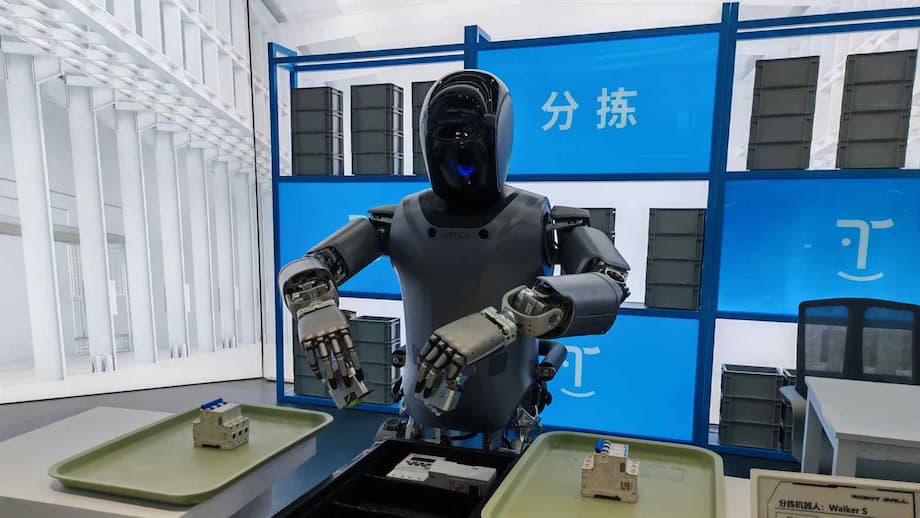China’s Humanoid Robot Boom: Spectacle, Investment, and Global Ambition
In recent years, China has become the epicenter of a humanoid robotics revolution, hosting a steady stream of large-scale exhibitions and competitions that have captured the imagination of the public and investors alike. From robots running marathons and boxing in the ring to shaking hands at graduation ceremonies, these events are more than just technological showcases—they are fueling a frenzy of investment and signaling China’s intent to lead the next wave of automation and artificial intelligence (AI).
- China’s Humanoid Robot Boom: Spectacle, Investment, and Global Ambition
- Why Are Humanoid Robots Center Stage in China?
- Inside China’s Humanoid Robot Exhibitions: From Marathons to Robot Battles
- The Investment Frenzy: Billions Flow Into Robotics
- Investor Caution: Hype vs. Reality
- China’s Competitive Edge: Supply Chains, Policy, and Public Enthusiasm
- Global Implications: The New Tech Arms Race
- Challenges Ahead: From Exhibition to Everyday Utility
- In Summary
While the commercial market for humanoid robots is still in its infancy, the scale and ambition of China’s efforts are drawing global attention. The country’s government, tech giants, and startups are pouring billions into research, development, and public demonstrations, hoping to turn science fiction into everyday reality. But behind the dazzling displays lies a complex landscape of technological challenges, investor caution, and international rivalry.
Why Are Humanoid Robots Center Stage in China?
Humanoid robots—machines designed to mimic the appearance and movements of humans—have long been a staple of science fiction. Today, thanks to breakthroughs in AI, machine learning, and advanced materials, they are rapidly becoming a reality. Unlike industrial robotic arms or mobile robots, humanoids are built for versatility, capable of navigating complex, human-centric environments and performing a wide range of tasks.
China’s push into humanoid robotics is driven by several factors:
- Technological ambition: Advances in AI, especially large language models and embodied AI (EAI), have made it possible for robots to process language, perceive their environment, and interact with humans in increasingly sophisticated ways.
- Economic necessity: With a shrinking workforce and rising labor costs, China sees automation as essential to sustaining productivity and economic growth.
- Global competition: As the U.S. and Europe ramp up their own robotics investments, China is determined to secure a leadership position in the next generation of intelligent machines.
- Government support: National and local policies, including the 14th Five-Year Plan for the Robotics Industry, provide funding, incentives, and infrastructure for robotics R&D and commercialization.
These drivers have created a fertile environment for innovation, with Chinese companies like UBTECH Robotics, Unitree Robotics, Xiaomi, and Fourier Intelligence emerging as global contenders.
Inside China’s Humanoid Robot Exhibitions: From Marathons to Robot Battles
China’s humanoid robot exhibitions are as much about spectacle as they are about science. At the 2024 World Robot Conference in Beijing, 27 humanoid robots made their debut—an unprecedented number—alongside more than 600 innovative products from 169 companies. Visitors watched robots perform long jumps, play Go, and interact with children, while Tesla’s Optimus robot made a guest appearance, underscoring the international stakes.
Other events have pushed the boundaries of what robots can do in public. In Hangzhou, Unitree G1 robots donned boxing gloves for the world’s first humanoid kickboxing contest, executing roundhouse kicks and elbow strikes with surprising agility. In Beijing, robots ran marathons and played soccer matches, their movements powered by AI algorithms rather than remote controls. These competitions expose robots to unpredictable, real-world conditions, generating valuable data for further development.
As Goldman Sachs analysts noted, “Real-world data is increasingly important to achieve consistency with physical-world and task accuracy.”
Such events are not just for show—they are critical testing grounds for both hardware and software, helping companies refine their products and demonstrate progress to investors and the public.
Robots in Everyday Life: Graduation Ceremonies and Beyond
Humanoid robots are also making appearances at more traditional public events. In July 2025, a robot named Shuang Shuang (“Bright”) walked the stage at a high school graduation in Fujian, shaking hands with teachers and receiving a certificate as cameras rolled. These moments, while symbolic, highlight the growing visibility of robots in Chinese society and the government’s efforts to normalize their presence.
Such high-profile appearances are part of a broader strategy to build public enthusiasm and attract investment. According to a Morgan Stanley survey, Chinese consumers are far more optimistic about the potential of humanoid robots than their American counterparts, with 67% expressing confidence in their widespread adoption within five years—double the rate in the U.S.
The Investment Frenzy: Billions Flow Into Robotics
The excitement generated by these exhibitions has translated into a surge of investment. In 2024 alone, China raised 8.45 billion yuan (about $1.2 billion) across 71 deals in humanoid robotics, while global funding for the sector jumped from $308 million in 2020 to $1.1 billion in 2024. The Chinese government’s National Development and Reform Commission has announced a state-backed venture capital fund targeting robotics and AI, aiming to attract nearly 1 trillion yuan ($137.8 billion) over 20 years.
Local governments in regions like the Pearl River Delta, Beijing, Shanghai, and Hangzhou are also providing funding and policy incentives, hoping to foster local champions and attract top talent. The Ministry of Industry and Information Technology has directed investment into research and development, while cities like Shanghai have drafted guidelines for humanoid robot development.
Major Chinese companies are investing heavily as well. Xpeng Motors, for example, claims to have operational humanoid robots in its automotive factories, while Xiaomi and Huawei are leveraging their resources and distribution networks to position themselves as future leaders in the field.
Where Is the Money Going?
Investment is flowing into both hardware and software:
- Core components: AI chips, servomechanisms, sensors, batteries, and electromechanical parts are all in high demand, with China’s markets for these components expanding rapidly.
- Software and AI: Large language models, machine learning algorithms, and cloud services are essential for enabling robots to understand and interact with their environment.
- Applications: Companies are targeting sectors like healthcare, manufacturing, logistics, and customer service, where robots can address labor shortages and improve efficiency.
China’s AI chip market is growing, though it still relies on foreign expertise for high-performance chips. The government recognizes the strategic importance of developing domestic capabilities, creating opportunities for both local and foreign investors.
Investor Caution: Hype vs. Reality
Despite the enthusiasm, some investors and industry veterans are urging caution. While exhibitions and competitions generate excitement, the commercial market for humanoid robots remains limited. Most current models are used for entertainment, research, or narrow industrial tasks, rather than as practical household or workplace assistants.
Wu Shichun of Plum Ventures commented, “Useful robots today are those with clear use cases, such as robotic vacuum cleaners and drones, rather than humanoid robots designed for spectacle.”
Alibaba’s Joe Tsai has expressed skepticism about the practicality of humanoid robots, suggesting that many scenarios still prefer human interaction. Other investors warn of a speculative bubble, citing inflated valuations and a lack of sustainable commercial customers, with most buyers being research institutions or government entities. Some firms have been accused of exaggerating sales by gifting robots to partners instead of making real commercial deals.
Technological bottlenecks persist, including spatial intelligence, hardware durability, and the ability to learn on the job. In one marathon test, only six out of 21 humanoid robots finished the course, highlighting the gap between demonstration and real-world utility.
Experts predict that while functional pilot applications may emerge within five years, it could take a decade or more for humanoid robots to have a broad impact on the workforce. In the meantime, investors are advised to focus on companies with clear real-world functionality and to avoid overhyped segments.
China’s Competitive Edge: Supply Chains, Policy, and Public Enthusiasm
China’s rapid progress in humanoid robotics is underpinned by several unique advantages:
- Robust supply chains: Decades of investment in manufacturing have given China a complete industrial chain for robotics, from key components to final assembly.
- Government support: Comprehensive policies and funding at both national and local levels provide a stable environment for innovation and commercialization.
- Public enthusiasm: Frequent media coverage and high-profile events have fostered a positive public attitude toward robots, encouraging adoption and experimentation.
- International recognition: Chinese teams recently secured the top two positions in the humanoid category at RoboCup 2025 in Brazil, using Beijing-based Booster Robotics’ T1 humanoid robots. This victory showcased China’s technical capabilities and innovation ecosystem on the world stage.
China’s industrial robot production has soared from 33,000 units in 2015 to over 550,000 in 2024, making it the world’s second-largest exporter of industrial robots. The humanoid robot market in China reached about 2.76 billion yuan ($380 million) in 2024 and is expected to hit 100 billion yuan by 2030.
Global Implications: The New Tech Arms Race
China’s humanoid robot boom is part of a broader global competition in robotics and AI. The U.S. and Europe are responding with their own investments and policy initiatives. Tesla is developing the Optimus humanoid robot, which aims to perform household chores and repetitive tasks, while Meta Platforms (Facebook’s parent company) has established a new division to develop AI-powered humanoid robots for consumer and industrial use.
Meta’s efforts focus on integrating advanced AI models with physical robots, aiming to create assistants that can perceive and navigate the 3D world. Other companies, like Nvidia-backed Figure AI and Google-backed Apptronik, are also pouring resources into the field. The international race is not just about technology, but also about setting standards, shaping markets, and influencing the future of work and society.
China’s approach—combining government support, industrial scale, and public enthusiasm—mirrors its strategies in electric vehicles, drones, and solar technology, sectors where it has become a global leader. Analysts believe that China’s “Physical AI” strategy could give it a similar edge in robotics, especially as it narrows the gap with global leaders in AI research.
Challenges Ahead: From Exhibition to Everyday Utility
Despite the progress, significant hurdles remain before humanoid robots become a common feature of daily life. Most current models are limited to narrow, repetitive tasks and lack the spatial intelligence and adaptability required for complex environments. Hardware durability, battery life, and real-world data collection are ongoing challenges.
Commercialization is also a major obstacle. While exhibitions and competitions generate excitement, turning prototypes into reliable, affordable products for homes and businesses is a much tougher task. Experts predict that the most promising applications in the near term will be in logistics, manufacturing, and healthcare, where robots can address specific labor shortages and improve efficiency.
As the technology matures, established tech giants with resources and distribution networks—such as Xiaomi, Huawei, and international players—are likely to dominate the market. Startups and investors will need to focus on clear use cases and sustainable business models to succeed in the long run.
In Summary
- China is hosting a wave of humanoid robot exhibitions and competitions, generating public excitement and a surge of investment.
- The country’s government, tech giants, and startups are pouring billions into robotics and AI, aiming to lead the next wave of automation.
- Exhibitions showcase robots in marathons, boxing matches, and public ceremonies, serving as both spectacle and critical testing grounds.
- Despite the hype, commercial adoption of humanoid robots remains limited, with most current models used for entertainment or research.
- Investors are urged to be cautious, focusing on companies with clear real-world applications and sustainable business models.
- China’s advantages include robust supply chains, government support, public enthusiasm, and international recognition.
- The global race in humanoid robotics is intensifying, with the U.S., Europe, and China all vying for leadership.
- Significant challenges remain before humanoid robots become a common feature of daily life, but the pace of innovation is accelerating.












